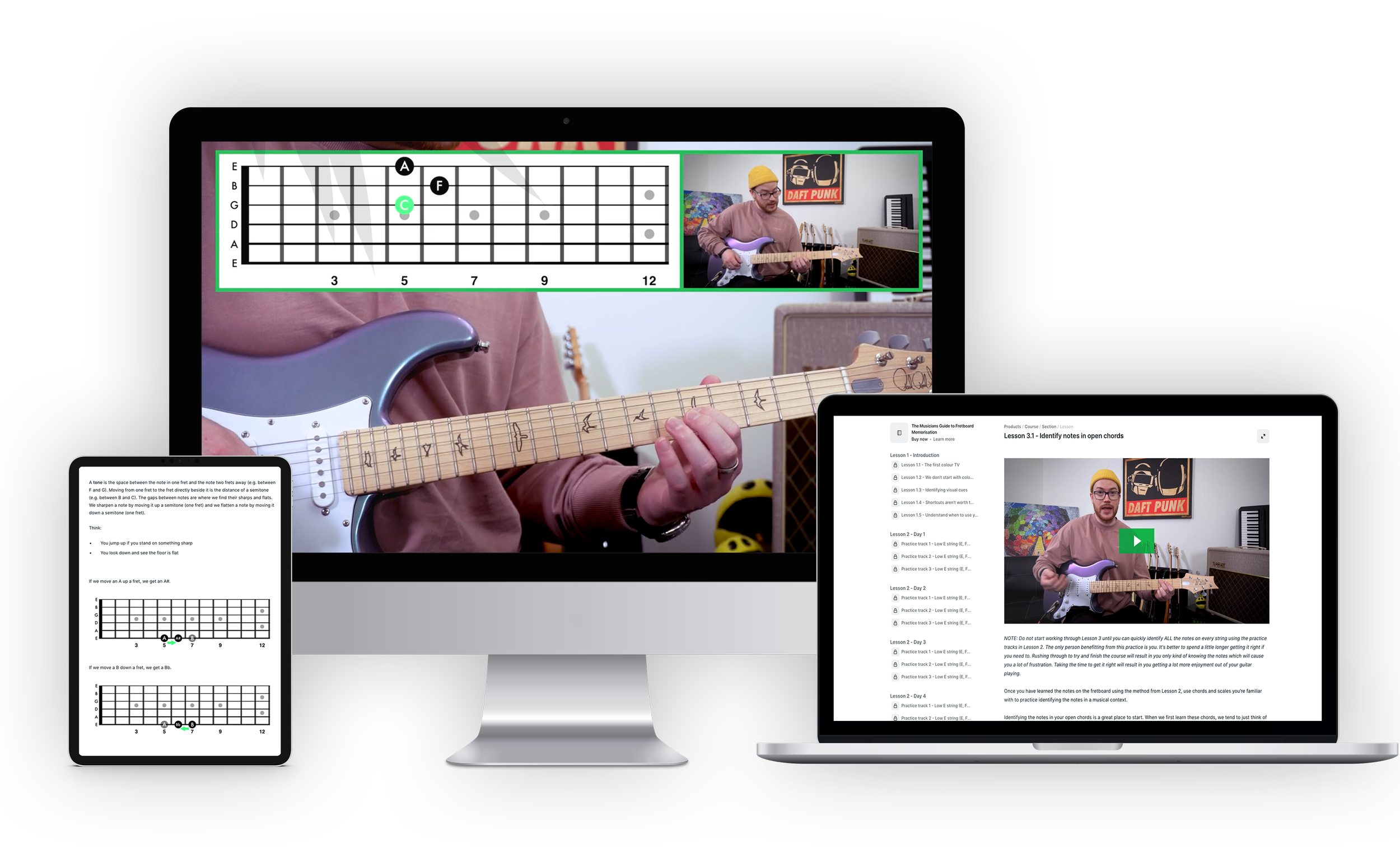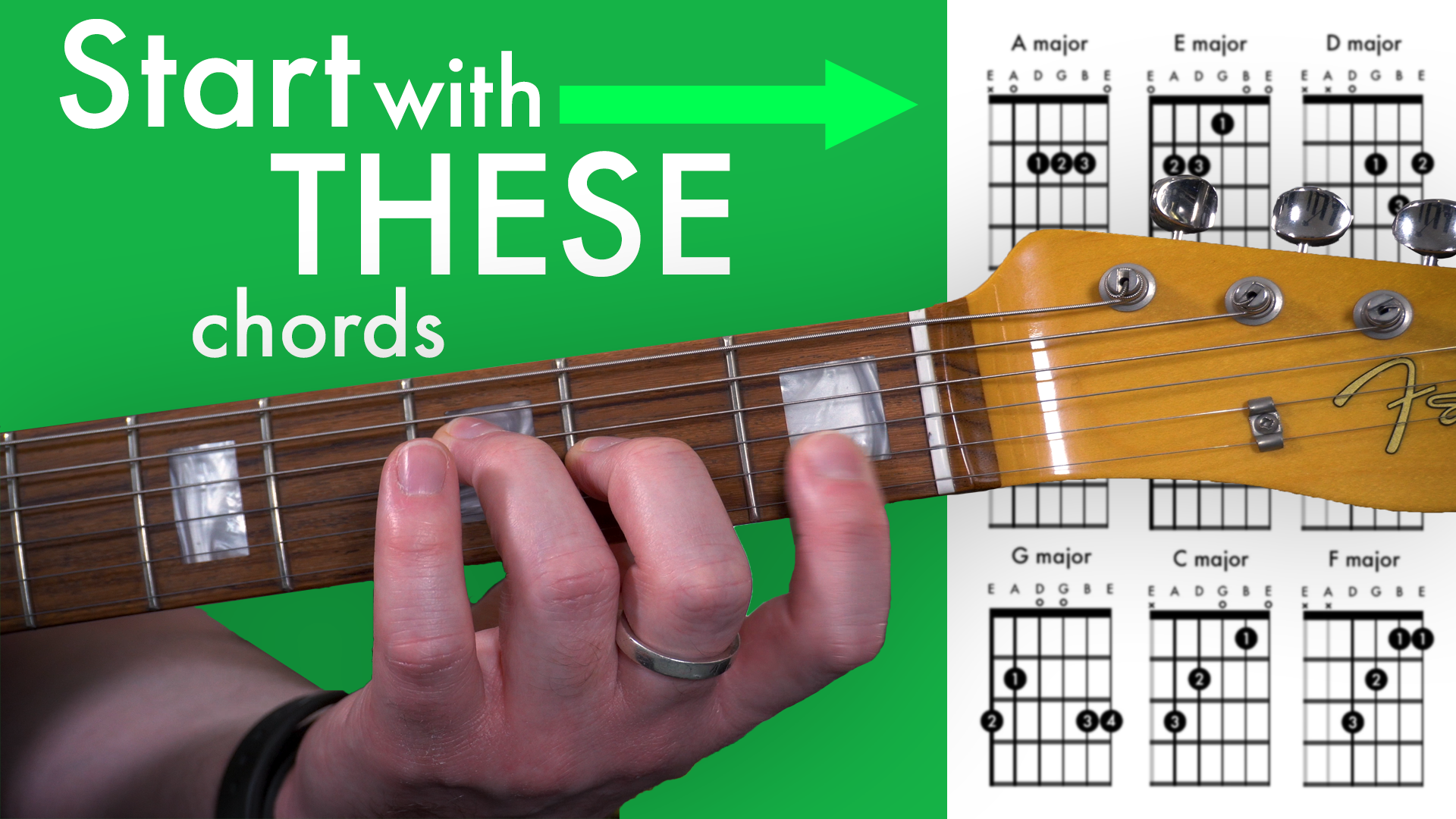Unlock the fretboard with one pentatonic shape
If you’ve played the guitar for any length of time, you’ve probably heard about the five pentatonic patterns. They are one of the first things you learn after you’ve got your head around some beginner guitar chords and learned to strum a few songs. But, the pentatonic scales are not just for beginners! They are a core part of your toolkit as a guitar player and are often used as a basis for all kinds of soloing and improvising. However…
I don’t think the way people typically go about learning the pentatonic patterns is very effective.
These shapes are useful. But, I don’t think they are as important as we think they are.
Fig. 1: A minor pentatonic pattern 1
Fig. 2: A minor pentatonic pattern 2
Fig. 3: A minor pentatonic pattern 3
Fig. 4: A minor pentatonic pattern 4
Fig. 5: A minor pentatonic pattern 5
These pentatonic patterns are fantastic for communicating where you’re playing on the guitar neck - someone will know exactly where you’re playing a riff if you say you’re using Pattern One. We should know them. But, I don’t think they are a good place to start. Trying to get your fingers familiar with five patterns - that you then need to learn how to properly apply before even touching the major scale - is not an effective use of your time.
In this lesson, we’re going to apply a tiny little bit of music theory to Pattern 1. You’ll discover that, with this one pattern and some minimal theory chops, you’ll be able to play the major pentatonic scale, the minor pentatonic scale, the major scale, and the minor scale anywhere on the fretboard in any key. That is so much more useful than learning five seemingly separate patterns! And, it’s going to take way less time to learn.
Minor pentatonic scale
We will start with Pattern 1. I always like to make the distinction between a pattern and a scale. A pattern is just a collection of notes laid out in a block on the fretboard. If you play up and down Pattern 1, you’ll notice that it starts on an ‘A’ and ends on a ‘C’.
Fig. 6: The A minor Pentatonic Pattern 1 starts on A (Low E string, fifth fret) and ends on C (High E string, eighth fret).
To play the A minor pentatonic scale you have to start on ‘A’ and end on ‘A’, playing through Pattern One.
Fig. 7: The A minor pentatonic scale starts on ‘A’ and ends on ‘A’, moving through Pentatonic Pattern 1.
Most people simply learn Pattern 1 as a collection of notes on the fretboard. Or they might learn to play from ‘A’ to ‘A’ through Pattern One (like we did above), but this still covers two octaves. The problem with practising the A minor pentatonic scale this way is that it’s very easy not to notice the ‘A’ chilling in the middle of the two-octave scale; the root note that joins the two octaves.
Fig. 8: It’s easy to miss the root note that connects the first and second octave.
It’s important to be able to physically play through two octaves. But, ironically, practising it this way actually makes it more difficult to apply music theory to what you’re doing (and the music theory is the magic here).
If we break the A minor pentatonic scale into two separate octaves, you’ll notice we get two patterns. The right expression of the scale with the notes arranged to the right of the root note.
Fig. 9: The right expression of the A minor pentatonic scale.
And the left expression of the scale with the notes arranged to the left of the root note.
Fig. 10: The left expression of the A minor pentatonic scale inside Pattern 1.
Now we have two very different patterns that we’ve extracted from the two-octave Pattern One. If we take into account the unique way the B string behaves, we can move this left expression up to the Low E string and play it from the same root note as the right expression.
Fig. 11: Taking into account the B string in order to play the left expression from the E string root note.
Now we can play the left and right expressions of the A minor pentatonic scale from the same root note. These scales are mirror images of each other. They sound exactly the same.
Fig. 12: The left and right expressions of the A minor pentatonic scale played from the E string root note.
If you know the notes of the fretboard you can apply the left and right expressions from any root note along the fretboard. Don’t get confused by the fact that the patterns look a little different. They are exactly the same shape on every string, you just have to account for the B string where appropriate.
Fig. 13: The left and right expressions of the A minor pentatonic scale played from the A string root note.
Fig. 13: The left and right expressions of the A minor pentatonic scale played from the A string root note.
Fig. 14: The left and right expressions of the A minor pentatonic scale played from the D string root note.
Fig. 15: The left and right expressions of the A minor pentatonic scale played from the G string root note.
You can now play your A minor pentatonic scales anywhere on the fretboard using two simple shapes: the left and right expressions of the minor pentatonic scale.
Discover how to learn the notes in a way that not only develops your fretboard fluency but reinforces your overall musicianship.
Major pentatonic scale
So far we have used Pentatonic Pattern 1 to play our minor pentatonic scale all over the fretboard. We can also use it to play our major pentatonic scale all over the fretboard. This time we will work with the key of C major. It’s the relative major of A minor, which means they share exactly the same notes. We will go through the same process we did with the minor pentatonic scale.
First, we will break the scale into two octaves, which will allow us to recognise the left and right expressions of the scale.
Fig. 16: The left expression of the C major pentatonic scale played through Pattern 1.
Fig. 17: The right expression of the C major pentatonic scale.
Once we have done this, we can take the B string into account and move the pattern to our root note on the Low E string.
Fig. 18: Taking into account the B string in order to play the right expression from the E string root note.
We can now apply these left and right expressions from every root note along the fretboard.
Fig. 19: The left and right expressions of the C major pentatonic scale played from the E string root note.
Fig. 20: The left and right expressions of the C major pentatonic scale played from the A string root note.
Fig. 21: The left and right expressions of the C major pentatonic scale played from the D string root note.
Fig. 22: The left and right expressions of the C major pentatonic scale played from the G string root note.
Major scale
At this point, we have used a single shape (Pentatonic Pattern 1) to play the left and right expressions of the major and minor pentatonic scales everywhere on the fretboard. However, we don’t have to stop there. A pentatonic scale is a five-note scale, which means it’s missing two of the notes that form the seven-note major scale. I often think of the pentatonic scale as a skeleton with the additional notes from the major scale being like muscles. We can add these additional notes to the major and minor pentatonic scales to create major and minor scales
Here are the left and right expressions of the C major scale.
Fig. 23: The left expression of the C major scale.
Fig. 24: The right expression of the C major scale.
Minor scale
And, the left and right expressions of the A minor scale.
Fig. 25: The left expression of the A minor scale.
Fig. 26: The right expression of the A minor scale.
These left and right expressions of the minor and major scales can be applied from every root note (just as we have done with the pentatonic scales above).
Blues scale
This principle of taking the left and right expressions of scales doesn’t have to stop here. We could add the blues note to the minor pentatonic scale, allowing us to play the left and right expressions of the blues scale.
Fig. 27: The left expression of the A blues scale.
Fig. 28: The right expression of the A blues scale.
This lesson only scratches the surface of how we can apply the pentatonic scale to significantly improve the effectiveness of our practice and progress on the guitar. We’re currently working on additional lessons and a course that will explore these ideas in a lot more detail. Please leave a comment if you have any questions so we can be sure to clarify anything in future content!
































A guitarist who has learned all the notes on the fretboard: Can more effectively learn scales and chords; Has a better understanding of keys, intervals, and scale degrees; Is able to more easily memorise songs; Has a greater capacity to understand music theory; Is more effectively able to develop their aural skills; Gets ‘lost’ far less frequently when they are improvising on the guitar.